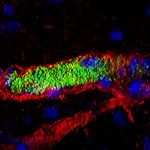New J. Phys. 20 015002
We study the active dynamics of self-propelled asymmetrical colloidal particles (Janus particles) fueled by an AC electric field. Both the speed and direction of the self-propulsion, and the strength of the attractive interaction between particles can be controlled by tuning the frequency of the applied electric field and the ion concentration of the solution. The strong attractive force at high ion concentration gives rise to chain formation of the Janus particles, which can be explained by the quadrupolar charge distribution on the particles. Chain formation is observed irrespective of the direction of the self-propulsion of the particles. When both the position and the orientation of the heads of the chains are fixed, they exhibit beating behavior reminiscent of eukaryotic flagella. The beating frequency of the chains of Janus particles depends on the applied voltage and thus on the self-propulsive force. The scaling relation between the beating frequency and the self-propulsive force deviates from theoretical predictions made previously on active filaments. However, this discrepancy is resolved by assuming that the attractive interaction between the particles is mediated by the quadrupolar distribution of the induced charges, which gives indirect but convincing evidence on the mechanisms of the Janus particles. This signifies that the dependence between the propulsion mechanism and the interaction mechanism, which had been dismissed previously, can modify the dispersion relations of beating behaviors. In addition, hydrodynamic interaction within the chain, and its effect on propulsion speed, are discussed. These provide new insights into active filaments, such as optimal flagellar design for biological functions.

